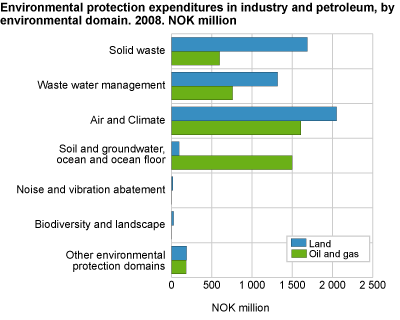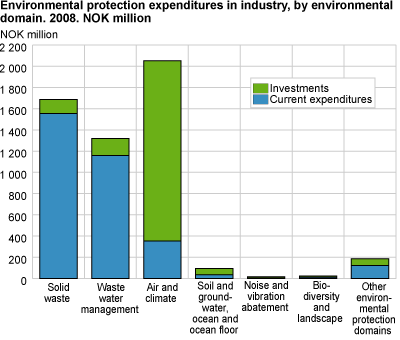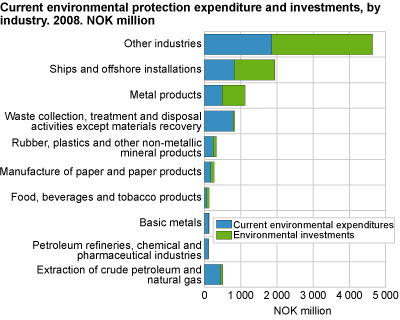Content
Published:
This is an archived release.
More spent on reducing air emissions
In 2008, the total environmental expenditures in mainland manufacturing industries and mining reached NOK 5.3 billion, of which NOK 3.2 billion was for current expenditures and NOK 2.1 billion for investments. For the first time, expenditures to limit emissions to the air dominate the environmental expenditures.
The survey of environmental expenditures covers mining and quarrying, manufacturing, electricity supply, water supply; sewage and waste management and remediation activities. Environmental expenditures in the petroleum sector were published earlier this year for the first time. See the article in Statistical Magazine: http://www.ssb.no/vis/magasinet/miljo/art-2010-06-11-01.html
The scope and the method for calculating the statistics on environmental expenditures were changed in 2008 (see textbox). This means that comparisons with previous years cannot be made for individual industries.
Reduction of air emissions largest item of expenditure
Total water supply; sewerage and waste management and remediation activities have dominated the environmental expenditures in earlier years. However, in 2008 investments in measures to control or prevent the emission of greenhouse gases and other air pollutants have increased strongly. Current expenditures and investments in this environmental domain are now 38 per cent of the total. Measures to prevent emissions to air are therefore the largest environmental domain in 2008.
Solid waste and wastewater have the largest environmental current expenditures
Of the total NOK 3.2 billion used on environmental current expenditures, 48 per cent is used on solid waste and 35 per cent is used on wastewater.
Solid waste and waste water management cover more than 75 per cent of total environmental current expenditures in all industries, except for the mining industry and the manufacture of basic metals. The mining industry also has significant expenditures on measures in the environmental domain of soil and groundwater, whereas measures against air pollution dominate the metal industry.
More on integrated technology investments than end-of-pipe investments
In 2008, a total of NOK 2.1 billion was used on environmental investments. NOK 1.2 billion was used on integrated technology investments and NOK 0.9 billion was used on end-of-pipe investments. (See the “about the statistics” on the uncertainty in allocating an environmentally motivated percentage to integrated technology investments.) With 80 per cent of total environmental investments, integrated technology investments targeting air and climate emissions dominated.
Large variations within the industries
The amount that each enterprise spends on environmental protection varies between the industries. For instance, more than half of the total environmental investments in Manufacture of coke and refined petroleum products, chemicals and chemical products and basic pharmaceutical products and pharmaceutical preparations can be attributed to one single enterprise. These industries spent a total of NOK 1.1 billion on environmental investments, primarily within cleaner production technology to reduce emissions to air.
More spent on energy savings than climate mitigation
The total environmental protection expenditures on reducing emissions to air were NOK 2.1 billion in 2008. Of this, two per cent went directly to reduce greenhouse gas emissions. NOK 17 million was for current expenditures and NOK 25 million was for investments. NOK 16 million was for end-of-pipe investments and NOK 8 million was for cleaner production technology. These figures are however uncertain.
Expenditures on reducing energy use are not included in the climate mitigation. Such expenditures amounted to NOK 166 million, NOK 49 million for current expenditures and NOK 17 million for investments.
Revised standard for industry classification
From the year 2008, a revised standard for industry classification is used (Nace rev. 2
http://www.ssb.no/emner/10/01/nos_sn/
). This has caused the exclusion of some enterprises and the inclusion of other enterprises, resulting in discontinuity in the statistics for environmental expenditures.
Publishing activities (Nace industry 58) is excluded from the scope of statistics from 2008. Nace industry groups D and E are included in the statistics for environmental industries. However, material recovery (part of group E), which was included in the scope of the statistics from 2002-2007, is excluded as from 2008.
The change to a revised standard for industry classification only influences the total figures for environmental expenditures to a minor degree. However, comparing the years 2002-2007 with 2008 for detailed industries is problematic. In addition to the revised standard for industry classification, the statistics for environmental expenditures in 2008 also include expenditures for measures to reduce emissions of greenhouse gases and other emissions to air. In the years prior to 2008, these two environmental domains could not be separated. Additionally, expenditures for energy-saving activities are now reported by the enterprises, since these activities have a direct or indirect effect on reducing emissions to air. |
Tables:
Contact
-
Martin Lundeby Grimstad
E-mail: martin.grimstad@ssb.no
tel.: (+47) 90 66 47 43
-
Trine Heill Braathu Randen
E-mail: trine.heill.braathu.randen@ssb.no
tel.: (+47) 91 10 67 45



